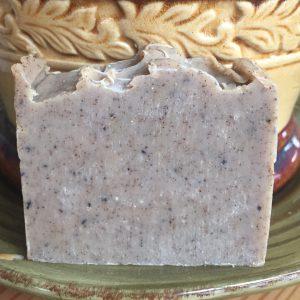DIY Coffee Soap Recipe
Maybe you are asking why a Coffee Soap Recipe? Why would I want to put coffee in my soap?
Coffee grounds act as a natural exfoliation to remove dead skin cells from the top layer of your skin. This helps to reveal the smooth, new skin underneath.
These grounds are gritty, but not abrasive, making them the perfect exfoliate.
Use the recipe below to make your own DIY Coffee Soap
Using the basic recipe #1 – this is one of my best cold process recipes
- 1800 Grams Olive Oil
- 450 Grams Coconut Oil
- 300 Grams Palm Kernal Oil
- 250 Grams Palm Oil
- 250 Grams Grapeseed Oil
- 420 Grams Lye (Sodium Hydroxide)
- 4.5 Cups Water
To make coffee soap I use coffee grounds that have run through the coffee machine already. I add about 1/2 cup of used grounds to this recipe and add them before adding scent.
I use a coffee scent and add 2 ounces of scent to this recipe.
Below is a picture of my coffee soap, where you can see the coffee grounds and the natural color the coffee gives the soap.
You can also use coffee in place of your water for a darker color.

Coffee Soap Benefits
The Benefits of adding Coffee to your Soap
Almost everyone knows coffee as the energy-boosting beverage we enjoy in the morning.
Millions of people love the taste of coffee and even those who don’t enjoy its flavour can appreciate its rich aroma.
Coffee is one of the most consumed beverages throughout the world, but it isn’t only useful as liquid refreshment, and it has many benefits when used in natural soap making.
Skin Exfoliation
We talked about this above using natural soap containing coffee to lather up your body and face will get rid of that dead skin and leave you with smoother skin everywhere.
Eczema and Acne Fighter
Coffee contains natural oils with enzymes that cleanse and unclog pores.
These enzymes are perfect for reducing acne and other skin irritations.
Because coffee oil is so easily absorbed, using natural soap with coffee leaves skin feeling smooth and soft.
Odour Absorber
When choosing a soap to have on hand in the kitchen, there is no better choice than natural soap with coffee. It will organically remove unpleasant food odours from your skin.
Sun Damage Prevention
Our bodies rely on antioxidants to fight the damage the sun does to our skin. This damage contributes to problems such as acne, eczema and premature signs of aging.
The fruit of the coffee plant contains the kind of powerful antioxidants our bodies need.
Using natural handmade soaps with coffee containing these potent antioxidants may help our bodies prevent and heal sun damage.
Reduces Puffy Eyes and Red Skin
Because the caffeine in coffee restricts blood vessels, natural products made with coffee can be an effective way to reduce the appearance of rosacea and redness.
The anti-inflammatory properties in coffee can reduce eye puffiness and may also eliminate dark circles by preventing blood from pooling under the eyes.
Keeps Hair Shiny
Soap making isn’t just about creating a product to clean bodies; it’s also about nourishing hair. The oils in coffee beans naturally keep hair moisturized, soft and glossy, so why not add brewed coffee in place of the water when making your next batch of shampoo bars.
Lifts Your Spirits
The intoxicating aroma of coffee is known to help people relax and clear their minds.
So why not add this wonderful aroma to a bar of soap to help enhance your energy and improve your mood.
Basic Cold Process Soap Making Instructions
Before starting gather all the equipment and ingredients you will need for you soap
Mixing your ingredients:
-
- Put on your protective clothing, apron, safety goggles, gloves etc
- Measure your water and pour it into the container you will be using for your lye/water mix
- Measure out your lye (sodium hydroxide)
- Slowly add the lye to the water, stirring to be sure it mixes well. This should be done in a well ventilated area as the fumes can be quite strong. This will only last for a 15 seconds or so. Stir until the lye is completely dissolved in the water. It will heat up to about 180 degrees and can now be put aside to cool down.
- While the lye/water is cooling use a scale and measure each of your soap oils and put into your stainless steel pot.
- Place this pot on your stove or hot plate and turn on low to heat to approximately 130 degrees.
- Once the oils have heated to 130 degrees take off the stove or hot plate and let them cool down to about 100 degrees.
- When the lye/water mix and the oils are both cooled down to about 100 degrees they are ready to be mixed.
- Slowly add the lye/water mix to your soap oils and stir you can use a stick blender and hand mix. Mix the soap until it traces. This is when the soap begins to thicken; you can test this by using your spoon to drizzle the liquid into the pot. You will see a trace that stays on the surface of the soap mixture.
- Once the soap has traced this is the time to add your scent and color.
- Mix the scent and color in well
- Pour this mixture into the lined molds, cover with a piece of cardboard or plastic, put it to bed (place a blanket over the soap mold) and let set for a day or two.
- Once it has sit for a day or two, remove the soap from the mold and cut and put out to cure for 4 to 6 weeks.
#handmadesoap #naturalsoap #makingsoapnaturally #soapmaking #soapmaking #soaps #artisansoap #bathandbody #cpsoap #coldprocesssoap #etsy #soapbase #soapcrafter #soapmaker #soaping #soapcrafting #soaphandmade #soap #giftidea #christmas #barsoap #handmadesoap #natural #organic #skincare #coldprocess #soapsupplies #coffeesoap #soaprecipe
© 2017 – 2025, Tes. All rights reserved.
